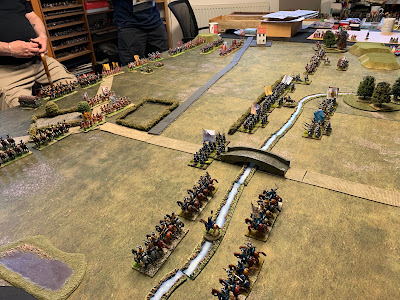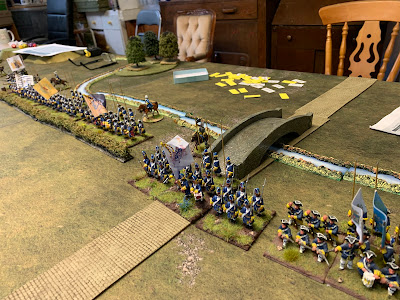Being on holiday this week allowed me to squeeze-in an additional game - Battle of Nyborg using Beneath the Lilly Banners. This battle was part of the Dano-Swedish wars of 1658 - 1660. Following the Swedes failed attempt to capture Copenhagen in the autumn of 1659, they dispersed their forces into winter quarters. The Danish-led coalition decided to attack part of the force near the coastal town of Nyborg.
The Swedes were somewhat surprised so had no defences ready but were able to cover their flanks with a lake and some woods. An unusual feature was that the Danish and German commanders could not agree who should be in charge and so each fought their own battle, which we simulated by having no overall C-in-C for that side. The Danish/Allies had 12*horse, 9*foot, and 2* light artillery. The Swedes had 8*horse, 7*foot, and 1*field artillery.
Allied left wing (east side) German horse with accompanying wagon Swedes wait in defence
The Allies advanced cautiously with their horse while their infantry pushed slowly through some fields in the centre of the field. The Swedes contented themselves with some long-range artillery fire that did cause one of the attacking Danish units to become shaken.
 |
| Swedes right wing horse (west) |
Seeing an opening the Swedes launched an attack on the Danish left and routed the shaken unit. They then poured more horse into the hole created and a fierce melee ensued in the east of the field.
 |
| Swedes breakthrough in the east |
Sensing the need to quicken the attack the Danish/Allied horse in the west launched an attack but were constrained by some marshy ground. Failing to charge, they were hit at the halt by the Swedes and pushed back. This meant the Swedes were pushing deep into the Allied position on both flanks and risked flanking the infantry centre.
 |
| Melee in the west |
 |
| More action in the east |
Despite their success the Swedes eventually ran of of fresh units and left the Danes with superior numbers in the west. As the infantry lines eventually clashed the Swedes inflicted damage on the advancing Allies from behind their improvised defences.
 |
| Allied reinforcements in the west |
By the time the mists had cleared on the cavalry melee on each flank, it was agreed the Swedes were in too good a position for the Danes to attack and so they withdrew leaving the field to the Swedes in a reversal of history.










No comments:
Post a Comment